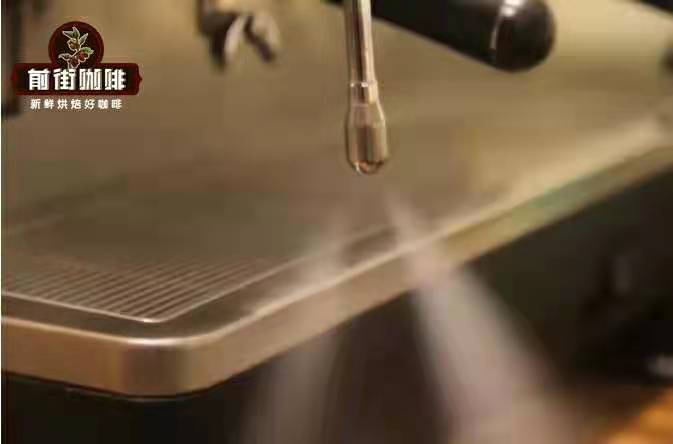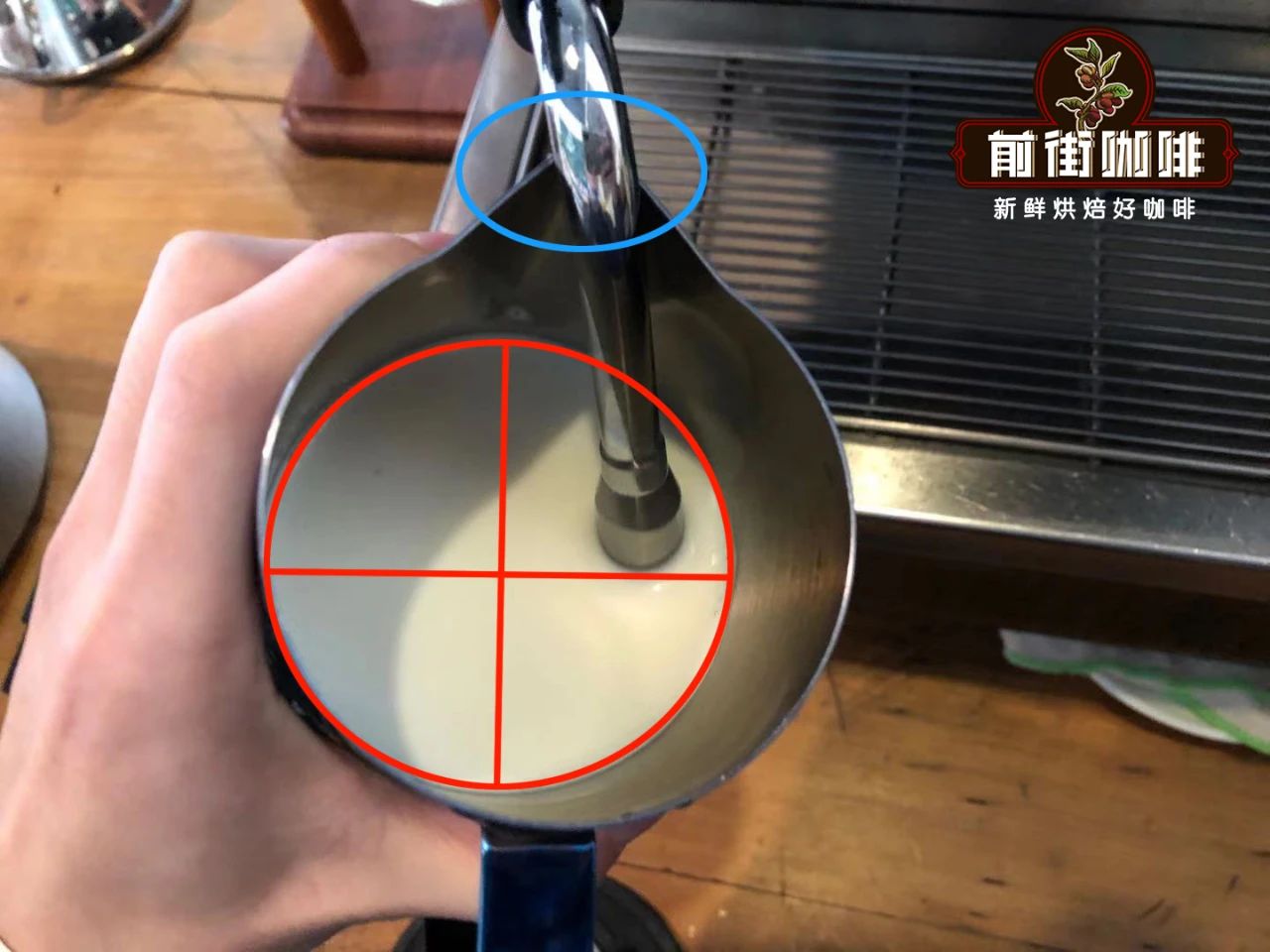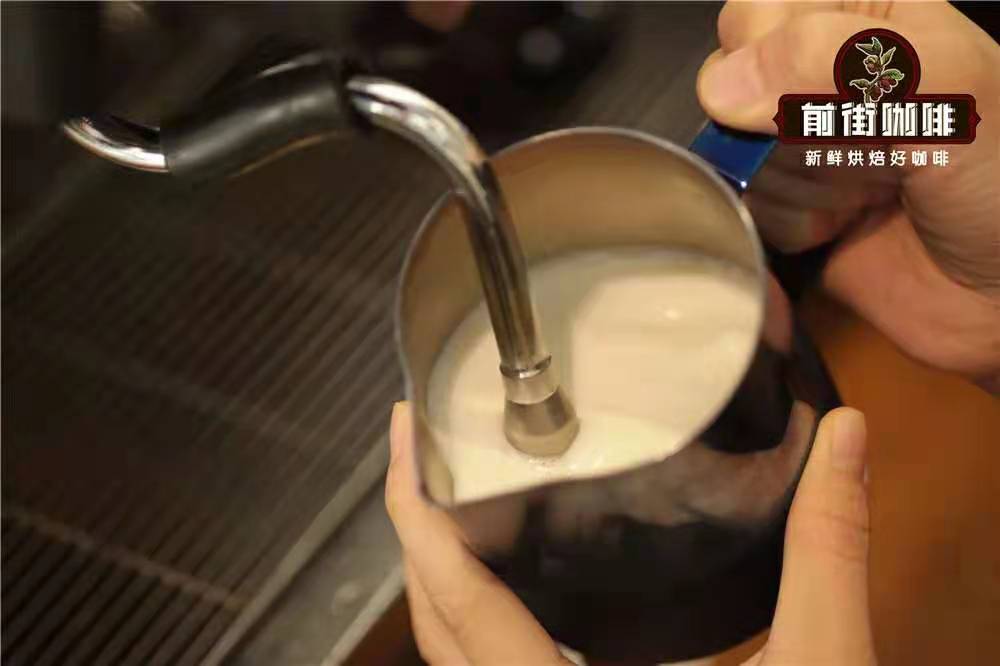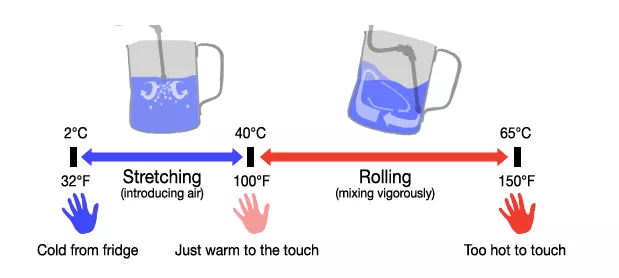How do I play latte milk foam? What is the thickness of espresso milk foam? Beginner's Milk foam course
Making milk bubbles was a hurdle that many milk coffee players could not get around. Then, even the blackboard in the front street was moved out, teaching everyone how to pass the smooth and delicate milk bubbles.

Why foam? Latte coffee began simply by heating milk and pouring it into the milk mix, without foam, and foam began to appear around the mid-20th century, when coffee machines were equipped with steam heating rods, and a coffee machine could make espresso and heat milk at the same time. But steam heating rods heat milk by pumping hot steam into it to make it hot. This heating produces foam whenever air is pumped into the milk. It was found that lattes with dense foam tasted better and had better insulation performance. As for the latte flower art that appeared later, it was a more thorough study of the technology of foam blowing.

How can novices master the technique of foaming milk? First of all, let's talk about the principle. The steam wand used by the coffee machine to stir milk will pump water steam into the milk to heat the milk. When the steam nozzle is in a semi-buried state (half in the milk and half exposed to the air), it will pump air into the milk. The protein of the milk will wrap this air and form milk foam. When the steam injector is completely buried, no new foam is created. Here we can get a knowledge point "the amount of milk foam (thickness) depends on how much air is injected, this process is called" send ", and the process of injecting air will emit" squeak ~ squeak ~"sharp sound, so some people will use" squeak "sound as a reference for the amount of air injected.

The milk foam produced when sending is very rough, that is, a lot of large bubbles, these large bubbles are very unstable, will soon burst, and very affect the taste, so you need a process called "cotton", in fact, it is very simple, is to bury the steam stick deep, so that it does not make a "squeaky" sound. At this time, the impact of water vapor will be used to break up the large milk bubbles and break them into many tiny milk bubbles. The structure of the tiny milk bubbles will be stable, more durable, and the taste will be good. And these two steps are carried out regularly, meaning that we should "direct" them to run in one direction, concentrate our efforts on destroying the enemy, instead of running around without discipline. So we'll use a whipping vat, which forms an angle with the steam head to create a swirl. Without delay, immediately come to a practical exercise 1, the best capacity of milk: milk needs a reasonable capacity, the front street recommends the use of 40-60% of the total capacity of the milk tank, too little milk and too much milk are very test technology, of course, in addition to this factor also depends on the amount of milk you actually use in a cup of coffee, avoid excessive waste. The milk tank used in the previous street had a capacity of 550ml and a filling volume of 250ml (just to the bottom of the mouth). 2, send the position: before preparing to send, first open the steam stick switch, release the condensed water vapor (release after the switch is closed). Then pull out the steam stick at an angle of 45 degrees. Use the cylinder nozzle to stabilize the position of the steam stick. This steam vortex is counterclockwise. The position of the steam stick is the right side of the liquid surface center cross. The steam stick is semi-buried.

3. Dismissed stage: Turn on the steam switch and you will hear the sound of "squeaking-squeaking". At this time, it is the dismissed stage. According to the thickness of the milk foam required, the time spent is different (the longer the time spent, the thicker the milk foam). Generally, 5 percent of milk is beaten to 6 percent (latte foam thickness), and the passing time is about 3 seconds. The milk rotates in a uniform direction to form a vortex.

4, the cotton stage: at this time, it is necessary to completely bury the steam hole, only heat, no longer send. Steam holes should not be buried at the bottom, it is recommended that the milk foam layer, which is conducive to cotton (rough milk foam fine). When will it stop? This depends on the temperature of your milk, which is generally controlled between 55-65 ° C. Too high temperatures denature proteins (heat denaturation of proteins in food generally occurs at about 60 ° C). 5, shaking and shaking tank: after playing milk foam, milk foam will gradually separate from milk, at this time can be shaken, so that milk foam and milk fully blend; and if there are still two or three big milk bubbles after playing milk foam, this is can use the milk tank to knock the desktop, shake the big bubbles, of course, this action will accelerate the powder layer of milk foam, so this action is enough for 1-2 times.
Time 00:08
In the above process, Qianjie summarized some practice methods for beginners to practice with ice water at the beginning of practice. Of course, this is not just to save milk. Er, er, it seems that it is really to save milk... In general, there are two points to master in water practice. One is to find a point suitable for creating a vortex. The air intake point mentioned in Qianjie is only one of countless methods. In fact, the air intake points of each barista in Qianjie are different. But that doesn't stop them from making fine milk bubbles. Therefore, what suits you is the best.

The second is to be familiar with the relationship between heating temperature and time. There are two stages in foaming milk, namely, the sending stage and the foaming stage. The whole time is the time taken for the milk temperature to be heated from 7-11℃ to 55-65℃. Basically, this time is fixed. Then, the time allocation between the passing stage and the foaming stage is different. Many novices spend more time in the passing stage, resulting in insufficient subsequent foaming time, and the milk foam will be very rough and easy to disintegrate.

Of course, there are also many beginners who have mastered the time well, but they still can't get rid of the dense milk foam. One of the main reasons is that the steam stick is buried too deep, so that the vortex will appear at the bottom, and the milk foam on the surface will not be beaten, but the heating effect will still be carried out. Therefore, it is best to bury the steam head at the stage of foaming to the position where it does not emit "squeaking" sound.
Important Notice :
前街咖啡 FrontStreet Coffee has moved to new addredd:
FrontStreet Coffee Address: 315,Donghua East Road,GuangZhou
Tel:020 38364473
- Prev

How do you drink Rosa coffee beans? How to make hand-brewed coffee from different producing areas of Rosa coffee beans?
How do you drink Rosa coffee? How to make hand-brewed coffee from different producing areas of Rosa coffee beans? The charming and exquisite coffee flavor of Rosa coffee beans has been on the minds of many coffee fans. Because the rose summer variety coffee tree is "picky" to the growing environment and the yield is low, the price of the coffee tree with exquisite flavor is naturally "intimidating".
- Next

What is the third wave of coffee? What is special about the third wave of fine coffee?
At present, the most popular coffee in the coffee industry is fine coffee. Fine hand-brewed coffee completely presents the unique flavor characteristics of coffee producing areas, so that the personality of coffee completely blooms in the mouth. Single-serve coffee is also increasingly popular with coffee drinkers. So why boutique coffee why is it so popular, it's with instant coffee and Italian
Related
- Beginners will see the "Coffee pull flower" guide!
- What is the difference between ice blog purified milk and ordinary milk coffee?
- Why is the Philippines the largest producer of crops in Liberia?
- For coffee extraction, should the fine powder be retained?
- How does extracted espresso fill pressed powder? How much strength does it take to press the powder?
- How to make jasmine cold extract coffee? Is the jasmine + latte good?
- Will this little toy really make the coffee taste better? How does Lily Drip affect coffee extraction?
- Will the action of slapping the filter cup also affect coffee extraction?
- What's the difference between powder-to-water ratio and powder-to-liquid ratio?
- What is the Ethiopian local species? What does it have to do with Heirloom native species?

